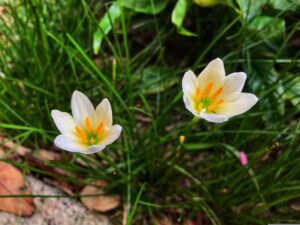Rain lilies, belonging to the genus Zephyranthes, are charming and delicate flowering plants known for their ability to produce colorful blooms after rainfall. These plants are native to various regions across the Americas, including the southern United States, Central America, and South America. They are typically found in grasslands, open woodlands, and meadows, where they thrive in well-drained soil and plenty of sunlight. They are prized for their resilience, adaptability, and the beauty they bring to gardens, landscapes, and natural habitats.
The name “rain lily” originates from the plant’s behavior of blooming shortly after a rainfall, often within a day or two. This unique characteristic adds an element of surprise and delight to gardens, as the flowers emerge seemingly overnight, carpeting the landscape with bursts of color.
Rain lilies feature narrow, strap-like leaves that emerge from bulbs or rhizomes. The foliage typically grows in clumps and ranges from dark green to bluish-green in color. The leaves may be semi-evergreen or deciduous, depending on the species and climate.

The most striking feature of rain lilies is their exquisite flowers, which appear on slender stalks above the foliage. The blooms are trumpet-shaped, with six petals arranged in a radial pattern. Rain lily flowers come in a variety of colors, including white, pink, yellow, and shades of purple. Some cultivars may exhibit bicolored or multicolored blooms.
Rain lilies are known for their prolific and often spontaneous blooming, which occurs after periods of rain or irrigation. Depending on the species and growing conditions, they may bloom intermittently throughout the growing season, with peak flowering typically occurring in spring or summer.
Rain lilies vary in size depending on the species and cultivar. Some species produce diminutive flowers that measure just a few inches in diameter, while others may have larger blooms up to 2-3 inches wide. The overall height of the plant, including the flower stalks, ranges from 6 inches to 1 foot tall.
These plants are relatively low-maintenance and are well-suited to a variety of garden settings. They thrive in well-drained soil and prefer full sun to partial shade. Rain lilies are often used in borders, rock gardens, containers, and naturalized areas, where their colorful blooms can be enjoyed up close.
In addition to their ornamental value, rain lilies also play a role in pollinator conservation, attracting bees, butterflies, and other beneficial insects to the garden with their nectar-rich flowers. Overall, rain lilies are prized for their graceful flowers, easy care, and ability to naturalize in garden settings. They add a touch of elegance and whimsy to flower beds, rock gardens, and container plantings, delighting gardeners with their colorful displays after rainfall.

Cultivars of Rain Lilies
Rain lilies encompass several species and cultivars, each offering unique characteristics and colors. Some popular cultivars include:
Zephyranthes candida: Also known as the white rain lily, this cultivar produces pure white flowers with a yellow center. It’s a classic choice for gardens and landscapes.
Zephyranthes grandiflora: This cultivar features large, showy flowers in shades of pink, ranging from soft pastels to vibrant hues. It adds a splash of color to garden beds and borders.
Zephyranthes ‘Labuffarosea’: With its striking rose-pink flowers and grass-like foliage, this cultivar creates a lovely contrast in mixed plantings or container gardens.
Zephyranthes ‘Minnie Pearl’: Named after the country music legend, this cultivar produces charming white flowers with a hint of pink blush on the petals. It’s prized for its delicate beauty.
Zephyranthes ‘La Buffa Rosa’: This cultivar features soft pink flowers with a darker pink blush at the center. It’s a lovely addition to rock gardens, where its blooms can cascade over stones.
Zephyranthes ‘Pink Rain’: True to its name, this cultivar produces abundant pink flowers that resemble delicate rose petals. It’s an eye-catching choice for borders and containers.
Zephyranthes ‘Golden Rain’: This cultivar stands out with its sunny yellow flowers, which add a cheerful pop of color to any garden setting.
‘Sulphur Queen’: Known for its soft yellow flowers with a hint of peachy orange, this cultivar brightens up garden beds and pathways.
Zephyranthes ‘Cherry Pink’: With its vibrant cherry-pink flowers and compact growth habit, this cultivar is perfect for small gardens or container plantings.
Zephyranthes ‘Twilight Zone’: This cultivar boasts striking purplish-pink flowers with darker pink streaks, creating a mesmerizing effect in the garden.
These are just a few examples of the many cultivars available, each offering its unique beauty and charm. Gardeners can choose from a wide range of colors and flower forms to create stunning displays of rain lilies in their landscapes.

Sunlight Requirement of Rain Lilies
Rain lilies generally prefer full sun to partial shade. They thrive in locations that receive at least 6 hours of direct sunlight per day but can tolerate some shade, especially in hot climates or during the hottest part of the day.
Temperature and Humidity Requirement of Rain Lilies
Rain lilies are adaptable to a wide range of temperatures but generally prefer warm to hot climates. They thrive in temperatures ranging from 70°F to 90°F (21°C to 32°C) during the growing season. These plants are native to tropical and subtropical regions and can withstand high temperatures, making them suitable for warm climates. Rain lilies prefer moderate to high humidity levels, similar to their native habitats.
Soil Requirement of Rain Lilies
Rain lilies are not very demanding when it comes to soil conditions but prefer well-draining soil with good fertility. Rain lilies can adapt to various soil textures, including sandy, loamy, or clay soils, as long as the soil is well-draining. Sandy or loamy soils are ideal as they provide good drainage. They thrive in slightly acidic to neutral soil conditions with a pH range of 6.0 to 7.0. Rain lilies prefer soil that drains well to prevent waterlogging, which can lead to root rot.

Propagation of Rain Lilies
Rain lilies can be propagated through seeds, bulb division, or offsets. Here’s how to propagate rain lilies using each method:
Seeds
Collect mature seeds from the seed pods of existing rain lilies once they have dried and turned brown. Sow the seeds in a well-draining potting mix in pots or trays. Press the seeds lightly into the soil surface and cover them with a thin layer of soil. Keep the soil consistently moist and place the pots in a warm, bright location with indirect sunlight. Germination usually occurs within a few weeks to months, depending on the species.
Bulb Division
Divide established rain lily clumps every few years to rejuvenate the plants and create new specimens. Wait until after the flowering period when the foliage begins to die back. Carefully dig up the clump, taking care not to damage the bulbs. Gently separate the bulbs from the clump, ensuring each division has several healthy bulbs and roots attached. Replant the divisions immediately in prepared soil or pots filled with well-draining potting mix. Water the newly divided bulbs thoroughly and keep them in a shaded area until they establish roots.
Offsets
Rain lilies produce offsets or bulbils around the base of the parent bulb. These offsets can be carefully detached and replanted to grow into new plants. Wait until the offsets have developed roots and are large enough to handle. Gently remove them from the parent bulb and plant them in pots or directly in the garden soil. Provide the same care as you would for mature rain lily bulbs, ensuring they receive adequate moisture and sunlight.
Regardless of the propagation method used, it’s essential to provide the newly propagated rain lilies with the appropriate growing conditions, including well-draining soil, adequate moisture, and sunlight, to encourage healthy growth and establishment.

Water Requirements of Rain Lilies
Once rain lilies are established and actively growing, they generally require regular watering to keep the soil consistently moist but not waterlogged. Water deeply when the soil surface feels dry to the touch, usually about once a week during the growing season. Provide enough water to penetrate the root zone, which is typically 6 to 8 inches deep.
Fertilizer Requirement of Rain Lilies
Rain lilies generally have modest fertilizer requirements. Apply fertilizer to rain lilies during the active growing season, which typically begins in spring and extends through summer. Avoid fertilizing during periods of dormancy or when the plants are not actively growing. Use a balanced, water-soluble fertilizer formulated for flowering plants.
Ornamental Uses of Rain Lilies
Rain lilies (Zephyranthes spp. and Habranthus spp.) are popular ornamental plants valued for their delicate, trumpet-shaped flowers and ease of cultivation. Here are some ornamental uses of rain lilies in the garden:
Border Plantings: Rain lilies are often used as border plants along pathways, garden beds, or garden borders. Their low-growing habit and charming flowers create a beautiful edge that adds visual interest to the landscape.

Container Gardening: Rain lilies thrive in containers, making them perfect for patio pots, hanging baskets, or window boxes. Their vibrant flowers provide a cheerful accent to outdoor living spaces, balconies, or decks.
Naturalizing: Rain lilies are excellent naturalizers and can be planted en masse in meadows, grassy areas, or under trees. When planted in drifts, they create a carpet of color that emerges after rain showers, hence their common name.
Cut Flowers: The delicate blooms of rain lilies make charming additions to cut flower arrangements or floral bouquets. Harvest the flowers when they are fully open but before they begin to wilt, and display them in vases or containers for indoor enjoyment.
Underplanting: Rain lilies can be used as underplantings for taller perennials or shrubs, providing a complementary backdrop to the larger plants. Their foliage remains attractive even when not in bloom, adding texture and color to the garden.
Mixed Borders: Combine rain lilies with other flowering bulbs, perennials, or annuals in mixed borders to create a diverse and colorful garden display. They pair well with plants that have similar cultural requirements and bloom times, enhancing the overall aesthetic appeal of the garden.
Overall, rain lilies are versatile plants that can be used in various ornamental applications to add beauty, color, and charm to the garden throughout the growing season. With their resilience and adaptability, they are valued by gardeners of all skill levels for their reliable performance and captivating blooms.


